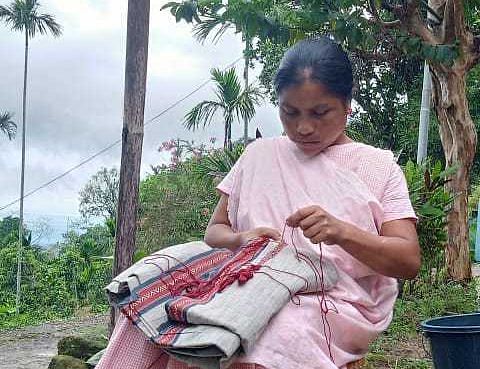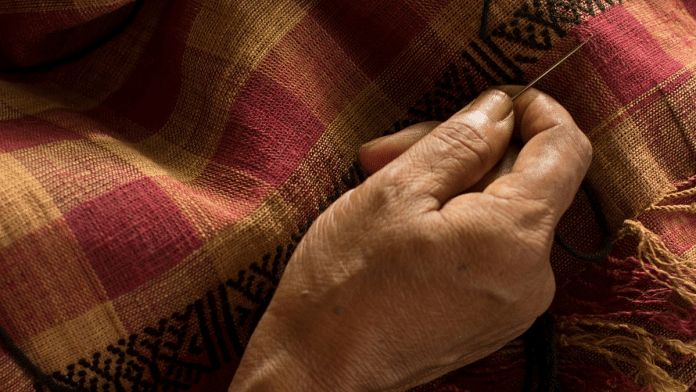For more than 200 years, the Mustoh village near the India-Bangladesh border was the only one in all of Meghalaya to boast a unique, multiline, centipede-like embroidery known as Khneng. However, with each passing generation, fewer people opted to learn how to stitch the intricate patterns.
It shocked Phrang Roy, a Khasi biodiversity activist, when he discovered in 2014 that only three women (two who are in their mid-40s and a 60 year-old) were left who know the craft.
Time was running out.
Roy and his organisation, the Shillong-based North East Slow Food & Agrobiodiversity Society (NESFAS), made it a mission to revive the Khneng embroidery technique.
Through rigorous workshops with the “three knowledge holders,” the number of artisans with Khneng knowledge increased to 20 by 2021. As word spread about the initiative and this one-of-a-kind form of embroidery, textile researchers, designers, and boutique owners from all over the country began reaching out about Khneng.
Earlier this year in March, Meghalaya-based designer Iba Mallai approached the women to sew a Khneng border on coats and dresses she had designed for the Lakme Fashion Week.
“This is about the revival of heritage. A tribal embroidery like Khneng, which is rooted in our nature and culture, is very unique. It is what exists in places like Mexico, the Mayans would do this kind of embroidery,” said Frederick Roy Kharkongor, commissioner and secretary of arts and culture department, Meghalaya.
Reviving a 200-year-old craft
The Khneng is typically sewn in a single or double-line along the borders of traditional Khasi attire. The intricate patterns include shapes, usually using black thread, made to resemble a ktiar – a centipede-like arthropod that is revered in Khasi culture.
While little is known about how Khneng came to be practised in Mustoh, it can be traced back around 200 years. The arduous process of stitching the Khneng patterns meant that fewer people chose to learn it over time.
Although the Khneng doesn’t involve working on heavy equipment like handlooms, the artisans have to painstakingly count the threads of the fabric and stitch the pattern to make sure that the motifs are evenly distributed. The women must sit for hours crouched over the eri silk cloth, known as ryndia, with their eyes trained on the stitches.
“The embroidery was dying over the years because people saw how tedious and time consuming it is…it can also take a toll on an artisan’s health affecting their back and eyesight,” said 45-year-old Victory Synrem, one of the three remaining women who knew the craft.

In 2014, Roy, whose family’s ancestral house is in Mustoh, found out about the Khneng from his relatives. By December of that year, he had begun visiting Mustoh to make inquiries. His conversations with the women he met during these visits were marked by a sense of urgency, and the initiative was born. The plan was to revive the Khneng by facilitating more women to learn about it from the last three “knowledge holders” – Victory Synrem (45), Bliwtibon Mawa (60), and Asibon Mawa (47).
“It was an eyeopener to see an organisation wanting to revive this art form, which is the pride and joy of our village and our culture,” Synrem said.
In the months of January and February of 2015, NESFAS conducted a 10-day workshop for eleven trainees, all of whom were village women in their late 20s to 60s.
“In the second phase in April 2016, in which nine of the eleven participated, advance patterns were taught on the traditional attire of Wars ((sub-tribe of Khasis) including jain peiñ (wraparound), jain kup (shawl), and jain iit (cape),” said Aurilia Tariang, a field coordinator with NESFAS.
Typically, the jain peiñ would have a thick band of Khneng running vertically while the jain kup would have two lines of the pattern running horizontally. The women were also taught three patterns of Khneng embroidery – ktiar, Treng and Khneng.
“I was inspired to learn Khneng embroidery because I was amazed at the intricate work…I am in the process of mastering the art work,” said 30-year-old Larihun Myrthong, one of the workshop participants.
Also read: This Gujarat cafe loves plastic waste. For all the right reasons
Power of a thread
Before venturing into the intricate world of Khneng, several women who participated in the workshops would do housework or make a meagre living selling betel nuts.
In November 2015, nearly seven months after the workshop, the women showcased their work, including pieces like stoles, clutches, and mufflers for the first time at the Indigenous Terra Madre event held in Shillong.
Eventually, the 12 artisans in collaboration with NESFAS formed the ‘Mei Ramew Khneng Embroidery Society, Mustoh’. According to NESFAS’s website , the group “aims to revive the dying art and enhance skill level and market sensitisation”.
“We also helped the women market their products through various means like holding a farmers market at our headquarters,” Tariang said, adding that it wasn’t long before textile researchers, boutique owners, designers, and fashion students from cities across the country, including Chennai, Bengaluru and Delhi, started reaching out to the women.
“Khneng was becoming increasingly popular. The women would receive orders to do it on fabric and send it back to them. They also recently received an order to embroider the pattern on a saree,” said Tariang.
Airilin Kongri (35), one of the artisans in the group, said that they are now getting two to three orders in a month. “I am still learning the process. So, I keep practising on my own fabrics,” she added.
In March this year, Khneng was put on the map. The pattern was featured on clothes designed by Ibo Mallai’s brand Kiniho in the Lakme Fashion Week. The pattern was used to tell an age-old Khasi folktale about a male deer – U Sier Lapalang.
In a bid to promote Khneng, the department of arts and culture is considering NESFAS’s proposal to build a handloom facility in and around Mustoh. According to Frederick Roy Kharkongor, the government hopes to develop Mustoh into an eri silk village like Umden-Diwon in Ri-Bhoi district.
“I know now that this art form will not die with us, but will still live on,” said Synrem.
Challenges
The project to revive Khneng, however, continues to face challenges. The 12 women were initially overwhelmed by the orders that were pouring in. As a result, last year, NESFAS conducted another workshop to teach a new batch of 10 trainees, of which two dropped out because of issues with their eyesight.
“We conducted the first phase of the workshop with eight participants, but we couldn’t complete the second phase because of a lack of funds,” said Tariang.
“We tried to convince them to come forward and participate in this project, but many still remain reluctant,” said an official from the department of textiles, who wished to remain anonymous.
According to Kharkongor, the government is keen to make some resources available for the workshops. “It needs to be developed going forward,” he said.
(Edited by Tarannum Khan)



